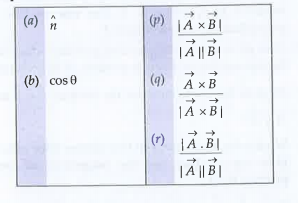If →c is the unit vector perpendicular to both the vector →aand→b, then what is another unit vector perpendicular to both the vectors →aand→b ?
→c×→a
→c×→d
−(→a×→b)∣∣→a×→b∣∣
(→a×→b)(→a×→b)
The correct Answer is:D
To find another unit vector perpendicular to both vectors →a and →b, we can use the properties of the cross product. Here’s a step-by-step solution:
Step 1: Understand the Cross Product
The cross product of two vectors →a and →b gives a vector that is perpendicular to both →a and →b. This can be expressed as:
→c=→a×→b
where →c is perpendicular to both →a and →b.
Hint: Remember that the cross product of two vectors results in a vector that is orthogonal to both.
Step 2: Determine the Unit Vector
A unit vector in the direction of →c is given by:
^c=→c|→c|=→a×→b|→a×→b|
This vector ^c is the unit vector perpendicular to both →a and →b.
Hint: To find a unit vector, divide the vector by its magnitude.
Step 3: Find Another Unit Vector
The cross product has a property that allows us to find another vector that is also perpendicular to both →a and →b. Specifically, we can take the negative of the unit vector:
−^c=−→a×→b|→a×→b|
This vector is also a unit vector and is perpendicular to both →a and →b.
Hint: The negative of a vector points in the opposite direction but retains the same magnitude.
Conclusion
Thus, another unit vector perpendicular to both →a and →b is:
−^c=−→a×→b|→a×→b|
Final Answer
The answer is:
−^c
The cross product of two vectors →a and →b gives a vector that is perpendicular to both →a and →b. This can be expressed as:
→c=→a×→b
where →c is perpendicular to both →a and →b.
A unit vector in the direction of →c is given by:
^c=→c|→c|=→a×→b|→a×→b|
This vector ^c is the unit vector perpendicular to both →a and →b.
The cross product has a property that allows us to find another vector that is also perpendicular to both →a and →b. Specifically, we can take the negative of the unit vector:
−^c=−→a×→b|→a×→b|
This vector is also a unit vector and is perpendicular to both →a and →b.
Thus, another unit vector perpendicular to both →a and →b is:
−^c=−→a×→b|→a×→b|
The answer is:
−^c
Topper's Solved these Questions
Similar Questions
Knowledge Check
- Question 1 - Select One
Which of the following is the unit vector perpendicular to →A and →B?
AˆA׈BABsinθBˆA׈BABcosθC→A×→BABsinθD→A×→BABcosθ - Question 2 - Select One
The vectors →a and →b are perpendicular if :
A→a.→b=0B→a.→b≠0C→a×→b=→0D→a×→b≠→0
Find a unit vector perpendicular to each of the vectors →a=3i+2j−3k and →b=i+j−k
View SolutionIf →c is perpendicular to both →a and →b , then prove that it is perpendicular to both →a+→b and →a -→b .
View SolutionIf →c is perpendicular to both →a and →b, then prove that it is perpendicular to both →a+→b and →a−→b.
View SolutionIf →a=i+2j+k,→b=2i+j and →c=3i−4j−5k, then find a unit vector perpendicular to both of the vectors (→a−→b) and (→c−→b)
View SolutionLet θ be the angle between two vectors →A and →B and ˆn is a unit vector perpendicular to their plane.
 View Solution
View SolutionTwo vectors →A and →B are inclined to each other at an angle θ. Then a unit vector perpendicular to both →A and →B
View Solution

